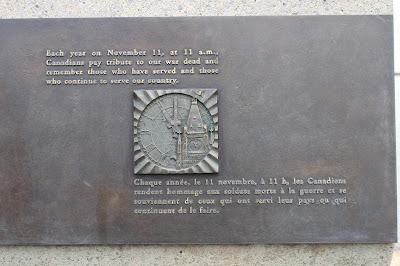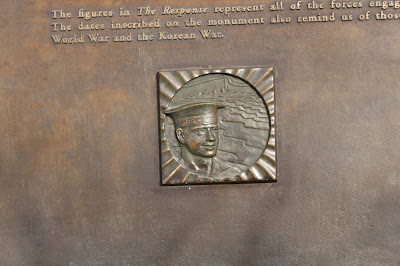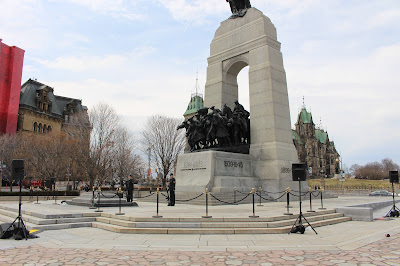I photographed the National War Memorial and posted the pictures on this site on
November 12, 2012. Since then, military guards are posted to the memorial in the summer months. Just recently the memorial has been renovated. I went and took some photographs of it on Sunday, April 9, 2017, the 100th anniversary of the beginning of the Battle of Vimy Ridge. There had been a ceremony for that battle earlier in the morning, most likely when I was photographing the Memorial Chamber. Some of the ceremony equipment remained on the site.
 |
Note the addition of the dates, '2001-2014'
the period of Canada's involvement in Afghanistan. |
 |
| This temporary structure shows the silhouette of the Vimy Memorial in France. |
 |
The figures in The Response represent all of the forces engaged in the First World War.
The dates inscribed on the monument also remind us of those who served in the Second
World War and the Korean War. |
 |
Les différents personnages de La Réponse représentent les forces engagées dans la Première
Guerre mondiale. Par ailleurs, les dates inscrites sur la monument rappelent le souvenir ce ceux
qui servirent le Canada durant la Seconde Guerre mondiale et la guerre de Corée. |
"WE WILL REMEMBER THEM...
"Approximately one in ten Canadians responded to the call to server our nation during the First and Second World Wars and the Korean War. Of the many Canadians who served, more than 116,000 made the ultimate sacrifice and did not return.
"The National War Memorial, entitled
The Response, was unveiled in May 1939 and was initially dedicated to commemorate the tremendous response of Canadians who served their country in the First World War. In May 1982 it was rededicated to honour those who served in the Second World War and the Korean War as well.
"Today, the monument also serves as a reminder of the contributions and sacrifices that Canadians are still making to preserve peace and freedom throughout the world.
"Many fought; many lost their lives. We will remember them."
 |
"The Memorial speaks to the world of Canada's heart. ...One sees at a glance the
answer made by Canada when the world's peace was broken and freedom threatened
in the fateful years of the Great War. It depicts the zeal with which the counry entered
the conflict."
King George VI,
unveiling of the National War Memorial, May 21, 1939 |
"NOUS NOUS SOUVIENDRONS D'EUX...
"Environ un Canadien sur dix servit son pays durant la Première et la Seconde Guerre mondiale et pendant la guerre de Corée. Plus de 116 000 personnes sacrifièrent ainsi leur vie pour leur patrie.
"Le Monument commémoratif de guerre du Canada, nommé
La Réponse, fut inauguré en mai 1939 pour honorer la mémoire des Canadiens qui répondirent si généreusement à l'appel et combattirent pour leur pays durant la Première Guerre mondiale. En mai 1982, cet ouvrage se voyait attribuer une nouvelle vocation afin de commémorer aussi le souvenir de ceux qui prirent part à la Seconde Guerre mondiale et à la guerre de Corée.
"Aujourd'hui, ce monummen rapelle en plus la contribution et les sacrifice que la population canadienne continue de faire pour maintenir la paix et sauvegarder la liberté dans le monde.
"De nombreux Canadiens — hommes et femmes — perdirent la vie pour leur pays, et nous nous souviendrons d'eux."
 |
« Ce monument rémoignera au monde entier du grand cœur des Canadiens, [...] Il représente
d'emblée la réponse que donna le Canada, lorsque la paix fut rompue et la liberté menacée,
dans les années critiques de la Grande Guerre, Il traduit le zèle avel lequel ce pays s'engagea
dans le conflit. »
Le roi George VI,
lors de l'inauguration du Monument commémoratif de guerre du Canada, le 21 mai 1939. |
 |
The figures of Peace, holding a laurel
wreath, and Liberty, holding a torch,
adorn the top of the monument's archway.
La figure de la Paix, tenant une couronne de
laurier, et celle de la Liberté, portant une
torche, surmontent l'arche du monument. |
 |
Many Canadians who defended peace
and freedom around the world were
laid to rest far from their homes.
Un grand nombre de Canadiens qui
défendirent la paix et la liberté dans le
monde furent inhumés loin de leurs foyers. |
 |
Each year on November 11, at 11 a.m.,
Canadians pay tribute to our war dead and
remember those who have served and those
who continue to serve our country.
Chaque année, le 11 novembre, à 11 h, les Canadiens
rendent hommage aux soldats morts à la guerre et se
souvient de ceux qui ont servi leur pays ou qui
continuent de le faire. |
 |
| Access ramps on both sides of the memorial are a new addition. |
 |
On May 28, 2000, through a millennial project of The royal Canadian Legion, the Unknown Soldier was
returned home and laid to rest in a tomb at the National War Memorial. The sarcophagus is patterned after the
altar of the Canadian National Vimy Memorial in Vimy, France. Some distinct features adorn the Tomb.
The Tomb of the Unknown Soldier is a Commonwealth War Graves Commission site. |
 |
A medieval sword, symbolizing courage
Une épé médiévale, symbolisant le courage. |
 |
Laurel leaves, symbolizing both victory and death
Des feuilles de laurier, représentant la victoire et la mort. |
 |
Le 28 mai 2000, dans le cadre d'un projet du millénaire proposé par la Légion royale canadienne, la dépouille du soldat
inconnu est déposée dans une tombe, au Monument commémoratif de guerre du Canada. Cette tombe s'inpire de
l'autel du Monument commémoratif du Canada à Vimy, en France. Elle est ornée d'éléments distinctifs.
Le Tombe du soldat inconnu est une sépulture reconnue par la Commission des sépultures de guerre du Commonwealth |
 |
Maple leaves, symbolizing Canada
Des feuilles d'érable, symbolisant le Canada. |
"THEY GAVE THEIR YOUTH...
"During the 20th century, over 1.7 million Canadians left their families, friends and homes to defend peace and freedom around the world. They went to war and, sadly, over 116,000 did not return — and some 28,000 of them have no known grave.
"The
Tomb of the Unknown Soldier represents all Canadians who die for their country in all conflicts — past, present and future. The Unknown Soldier fought and died near Vimy Ridge in France during the First World War. His remains were originally laid to rest in a nameless grave in the Cabaret-Rouge cemetery in Souchez, France. His identity, his life and his hopes remain unknown."
 |
"This unknown soldier was not able to live out his alloted span of life to
contribute to his country. But in giving himself totally through duty,
commitment, love and honour he has become a part of us forever. As we are
part of him."
Her Excellency the Right Honourable Adrienne Clarkson,
Governor General of Canada
Eulogy for the Unknown Soldier, May 28, 2000 |
"ILS ONT DONNÉ LEUR JEUNESSE...
"Pendant le XXe siècle, plus de 1,7 million de Canadiens quittèrent leurs familles, leurs amis et leur foyers pour défendre la paix et la liberté dans le monde. Ils firent la guerre et, malheureusement, plus de 116 000 d'entre eux ne revinrent jamais au pays, dont 28 000 qui n'ont pas de lieu de sépulture connu.
"La
Tombe du soldat inconnu répresente tous les Canadiens qui sont morts ou mourront pour leur pays lors de conflits. Le soldat inconnu combattit et mourut près de la crête de Vimy en France durant la Première Guerre mondiale. Sa dépouille avait auparavant été déposée dans une tombe non identifiée du cimetière du Cabaret-Roughe, à Souchez, en France. Son identité, sa vie et ses espoirs demeurent inconnus."
 |
« Ce soldat inconnu n'a pas été capable de vivre les longues années qui auraient dû être siennes pour continuer de contribuer à son pays. Mais en se donnant entièrement à son devoir, à son engagement, à son amour et à son honneur, il est devenu une partie de nous pour toujours. Et nous sommes aussi une partie de lui. »
Son Excellence la très honorable Adrienne Clarkson,
Gouverneure générale du Canada,
dans un éloge funèbre en l'honneur du soldat inconnu, prononcé le 28 mai 2000. |
 |
Three corners of the Tomb feature replicas of the Memorial Cross.
Each cross is slightly different, as it bears the Royal Cypher of the
sovereigns, George V, George VI or Elizabeth II. The Memorial Cross
is presented to the families of those who gave their lives while
serving in an area of hostilities outside of Canada.
Trois des pièces angulaires de la Tombe sont ornées des répliques de la Croix du Souvenir. Ces croix,
légèrement différentes les unes des autres, portent chacune le monogramme royal de l'un des
monarques : George V, George VI ou Elizabeth II. La Croix du Souvenir est présentée aux familles
de personnes qui ont donné leur vie pour leur patrie, en terre étrangère, lors de conflits. |
 |
The fourth corner bers the poppy,
symbol of sacrifice and remembrance. It
is worn by thousands of Canadians on
Remembrance Day, Novemeber 11.
Sur la quatrième pièce angulaire, un coquelicot
symbolise le sacrifice et le souvenir. Le 11 novembre,
jour du Souvenir, des milliers de Canadiens portent
un coquelicot symbolique. |
 |
The establishment of this Tomb honours
the sacrifice of those who have fallen in
wars past and those who may once again
be called to serve in the future.
Cette tombe honore le sacrifice des
Canadiens morts au combat et des
personnes qui, dans l'avenir, pourront
être appelées à servir leur pays. |




























































































